
by John Henshall

From left to right: DCS 100, DCS420, DCS 200

by John Henshall

The Kodak DCS range of professional digital cameras are outstanding benchmark products which have had a major influence on the development of digital cameras over the past seven years. They are the most significant range of digital cameras yet made.
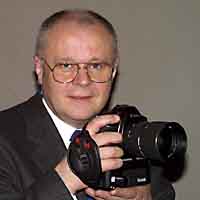 The
advent of the new DCS520 is therefore important news. I had the
opportunity to put a pre-production DCS520 through its paces before
and during my digital photography seminars at the Seybold conference
in New York, March 1998.
The
advent of the new DCS520 is therefore important news. I had the
opportunity to put a pre-production DCS520 through its paces before
and during my digital photography seminars at the Seybold conference
in New York, March 1998.
The DCS520's electronics and software are designed
and manufactured by Kodak, while the special EOS1N camera body,
viewfinder, metering and lens system are designed and manufactured by
Canon. The camera is more compact than previous DCS cameras and
weighs 1.65 kg (over 3.5 pounds) plus battery, PC card and lens.
Kodak's policy of using established SLR systems ensures that the main
operational controls of their cameras are already familiar to users.
But Kodak seem to have moved away from their early favourites - Nikon
- to Canon, who will also market this camera as the EOS D2000.
LENSES
 The
DCS520 accepts the full range of Canon EOS lenses, though their focal
length is effectively multiplied by a factor of about 1.5 - a 28mm
lens acts as though it is 42mm. This is because the lenses are
designed to cover 35mm film's 36 x 24mm frame area while the CCD
measures about 23 x 16mm. This is a slight drawback but something I
prefer to the use of relay optics, which have other drawbacks. Kodak
should put the same CCD into one of Canon's excellent APS cameras,
which would then almost fill the smaller frame area of 30.2 x 16.7mm.
The viewfinder has a built-in magnifier, which brings the viewfinder
image up to a good size.
The
DCS520 accepts the full range of Canon EOS lenses, though their focal
length is effectively multiplied by a factor of about 1.5 - a 28mm
lens acts as though it is 42mm. This is because the lenses are
designed to cover 35mm film's 36 x 24mm frame area while the CCD
measures about 23 x 16mm. This is a slight drawback but something I
prefer to the use of relay optics, which have other drawbacks. Kodak
should put the same CCD into one of Canon's excellent APS cameras,
which would then almost fill the smaller frame area of 30.2 x 16.7mm.
The viewfinder has a built-in magnifier, which brings the viewfinder
image up to a good size.
I used three excellent Tokina AT-X lenses from Introphoto for my shots with the DCS520: 17mm ƒ3.5 (£349 street), 28 - 70mm PRO ƒ2.6 zoom (formerly the highly acclaimed Angénieux zoom - £499) and 80 - 200mm PRO ƒ2.8 (£749).
BATTERY
A removable Ni-Cad battery pack enables batteries to be swapped without waiting for the camera itself to recharge. The battery recharges in an hour, though this can be done only in the separate twin-slot charger, not in the camera. Battery life is said to be 100 shots if the LCD screen is used, rising to 250 if not.
NEW CCD
A new 2 megapixel CCD produces 1728 x 1152 pixel images. Raw images are 2MB, before colour-interpolation, using a Photoshop plug-in. This converts them to RGB files of just under 6MB. Images are sampled in the camera at 36 bits - 12 bits per colour channel - and may also be acquired into Photoshop as 36 bit (11.4MB) files. The aspect ratio is 1.5 to 1, the same as 35mm film. The new chip has much greater blue response, which improves the blue noise experienced with earlier DCS cameras. Red sensitivity has also been improved.
A SPEED FOR ALL REASONS
The ISO range is a generous 200 to 1600, which makes the camera especially suitable for photojournalism and indoor sport. Other uses include catalogue work up to about half page, editorial photography, commercial, portraits up to about 8 x 10 inches, law enforcement and military. The DCS520 would be a good all-round medium resolution digital camera.
WHITE BALANCE
The DCS520 has preset white balance settings for daylight, tungsten, fluorescent and flash. It can also be set to white balance automatically, sensing the colour temperature of the ambient light.
ANTI-ALIASING
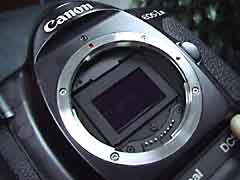
A newly developed anti-aliasing filter reduces the effect of colour fringing, which was sometimes objectional in the earlier Kodak digital cameras. This thin, rectangular multi-coated filter is mounted immediately behind the lens, in front of the mirror.
'MOTOR' DRIVE
The camera has a
faster shooting rate than earlier cameras - 3.5 frames per second in
14 frame bursts before having to take time out to write to the
removable PC storage card. Type II and Type III cards can be used - a
520MB card being able to store over 250 images.
INSTANT GRATIFICATION
 Images
may be reviewed instantly on a small, back-of-camera LCD screen. This
shows exposure data, histogram to assist setting exposure and an
over-exposure indicator which flashes to show burnt-out highlights -
the first time we have seen this feature since the first DCS100 in
1991. Images may be displayed singly, or in blocks of four or nine.
As the thumbwheel is turned, successive images come up instantly.
This responsiveness is impressive and although the screen is small it
packs a lot of useful data, including filename, date and time of
exposure, ISO setting, shutter speed, aperture, exposure
compensation, a histogram and - incredibly - it still has room for a
small colour image, which can be zoomed up to full screen. Folders
may be created on the PC card and selected to store images for
different assignments.
Images
may be reviewed instantly on a small, back-of-camera LCD screen. This
shows exposure data, histogram to assist setting exposure and an
over-exposure indicator which flashes to show burnt-out highlights -
the first time we have seen this feature since the first DCS100 in
1991. Images may be displayed singly, or in blocks of four or nine.
As the thumbwheel is turned, successive images come up instantly.
This responsiveness is impressive and although the screen is small it
packs a lot of useful data, including filename, date and time of
exposure, ISO setting, shutter speed, aperture, exposure
compensation, a histogram and - incredibly - it still has room for a
small colour image, which can be zoomed up to full screen. Folders
may be created on the PC card and selected to store images for
different assignments.
SCSI OUT, FIREWIRE IN
Faster image retrieval via FireWire, with no SCSI alternative, is a brave step in a world likely to be dominated by SCSI for some time yet. I believe it to be a good decision, which may start a trend and persuade laptop manufacturers to fit FireWire as standard. And there's still the back-up of being able to slot the PC card directly into a laptop or card reader. That's how I used the camera, on location. Unfortunately there is no provision for a video output to feed a tv monitor, either live or in picture review mode.
WITHER THE DCS460?
The DCS520 now makes the top-of-the-line 6 megapixel DCS460 look a little long in the tooth. Remember your school days? "DCS420 is to DCS520 as DCS460 is to … ?" Kodak are saying nothing but it will be quite something if it comes.
HARDWARE REQUIREMENTS
|
|
|
|
Shoot with confidence 1728 x 1152 pixel CCD Wide ISO range 200 to 1600 3.5 images per second 14 images per burst Immediate exposure feedback No relay optics Firewire (IEEE1394) output |
Focal length magnification No video output Price (£9,995 without PC card or lens but including one battery.) |
DCS 520 - THE IMAGES
Remember... these images are all heavily compressed for viewing on the Web - we have your download times to consider. So please don't make any judgement based solely on them. We include them simply to demonstrate how the camera handled a variety of subjects.
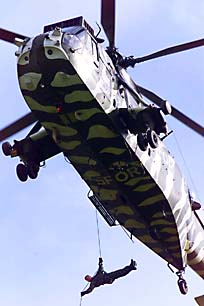 This
shot was used as the Cover Photograph for 'The Photographer'
Magazine, April 1998
This
shot was used as the Cover Photograph for 'The Photographer'
Magazine, April 1998
Ninety feet under a Royal Navy Sea King helicopter is like being inside the world's biggest - and noisiest - hair drier. (Not that a baldie like me knows what it's like beneath a regular hair drier, you understand.) Avoiding freezing to death from the wind-chill, being blown over, and getting a descending Royal Marine's boot in the face, become the primary concerns. In these circumstances a camera which takes care of everything is a godsend. Tokina 28 - 70mm zoom at 70mm, 1/800 second ƒ6.3, ISO 400. Taken at 10.38am on 12 March 1998. The DCS520 records this data - and more.
The DCS520 image file produces a 9.75 x 14.63 cm (3.84 x 5.76 inches) image at the 300 pixels per inch needed to reproduce at best quality using The Photographer's 200 line printing screen. So I interpolated the image up to 21.6 x 32.4 cm (8.5 x 12.75 inches). The printed page uses the full width of the image, with a little cropped from top and bottom to reduce the aspect ratio from 1.5 - 1 to the 1.414 - 1 of an A4 page. I increased colour saturation (to help the hazy sky) and made the image a little darker before applying unsharp mask, as we would with any other reproduced image. Blowing up to a 34.8MB CMYK file for a full page of A4 is pushing it for two million pixels but I reckon the DCS520 can just do it. That's some achievement.
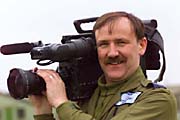
Special thanks to Sgt. Ralph Brooks and the Joint Air Transport Executive, RAF Brize Norton, who wanted to be the first to see the DCS520 in action. Fortunately it was our kind of action, not the military kind.
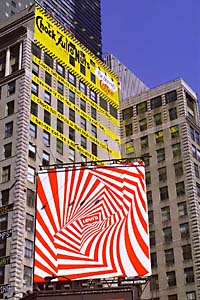
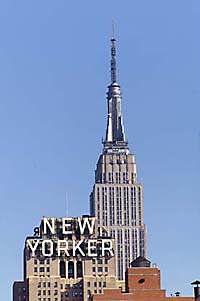
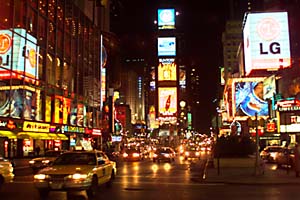
Times Square by
night
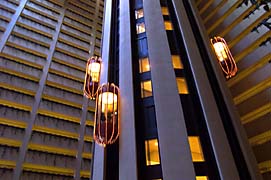
Elevators inside the
New York Marriott Marquis Hotel
AND FINALLY…
Much careful thought has gone into the DCS520's features, which are better than any other self-contained camera currently offers. Even at £9,995, the DCS520 is likely to be in short supply for some months to come. The histogram brings you control over your images; the facility for instant replay brings you security.
The DCS520 is a beautifully designed no-compromise digital camera which exudes Kodak's extensive digital camera experience and, for the first time, gives you the confidence of knowing when you have got the shot. Not even film can do that.